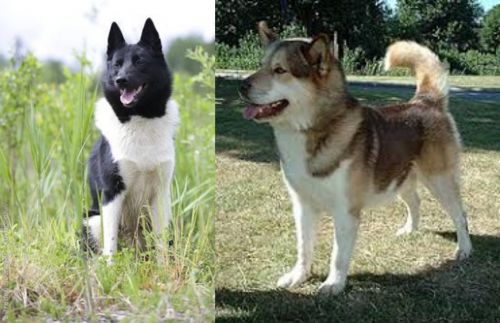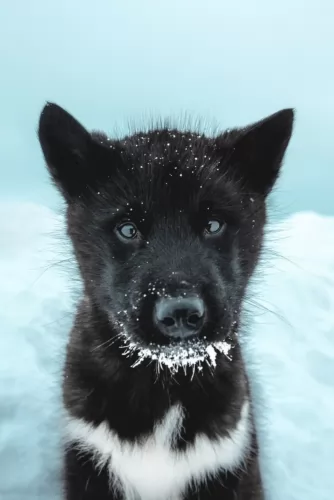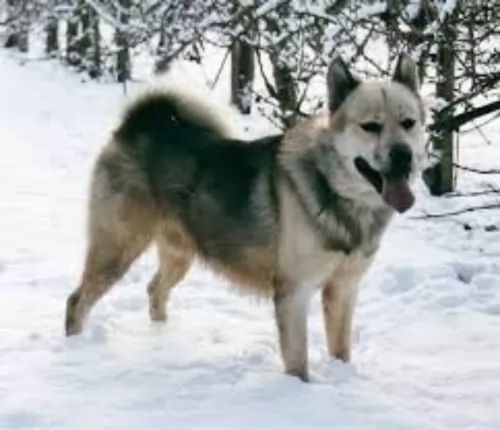 MyDogBreeds
MyDogBreeds Russo-European Laika is originated from Russia but Greenland Dog is originated from Greenland. Russo-European Laika may grow 8 cm / 3 inches shorter than Greenland Dog. Russo-European Laika may weigh 12 kg / 26 pounds lesser than Greenland Dog. Both Russo-European Laika and Greenland Dog has almost same life span. Both Russo-European Laika and Greenland Dog has same litter size. Russo-European Laika requires Low maintenance. But Greenland Dog requires Moderate maintenance
Russo-European Laika is originated from Russia but Greenland Dog is originated from Greenland. Russo-European Laika may grow 8 cm / 3 inches shorter than Greenland Dog. Russo-European Laika may weigh 12 kg / 26 pounds lesser than Greenland Dog. Both Russo-European Laika and Greenland Dog has almost same life span. Both Russo-European Laika and Greenland Dog has same litter size. Russo-European Laika requires Low maintenance. But Greenland Dog requires Moderate maintenance
 The Russo-European Laika is a hunting dog that comes from Russia.
The Russo-European Laika is a hunting dog that comes from Russia.
It is a dog that has been developed from Spitz type dogs. A breeding program was started for the dog in 1944.
The Russo-European Laika dog is recognized by the Federation Cynologique Internationale in the Spitz and Primitive type group.
 The Greenland dog is an ancient breed of dog hailing from Greenland. The dog was brought to North American from Siberia hundreds of years ago. In fact the very first dogs arrived in the Americas some 12,000 years ago.
The Greenland dog is an ancient breed of dog hailing from Greenland. The dog was brought to North American from Siberia hundreds of years ago. In fact the very first dogs arrived in the Americas some 12,000 years ago.
The Greenland Dog isn’t recognized by the AKC but it is recognized by a number of other groups. While the Greenland Dog is valued in Greenland, it isn't particularly well known in other parts of the world.
 The Russo-European Laika is a medium sized dog Spitz dog that stands at between 54 to 60cm in height and weighs in the region of 20 – 23kg.
The Russo-European Laika is a medium sized dog Spitz dog that stands at between 54 to 60cm in height and weighs in the region of 20 – 23kg.
The dog has quite a strong resemblance to the Karelia Bear Dog. They are sometimes mistaken for each other.
The Russo-European Laika has the typical triangular shaped head with small dark eyes, a black nose and erect, pointed ears. These are deep chested dogs.
As with other Spitz breeds, this dog has a thick fur with a densely furred tail which is curved over the back. The double coat is fairly long and usually a dark grey color or black with some white markings. Sometimes the dog has a white coat.
This is a lively, energetic dog breed that loves to spend time outdoors. It has always been used to alert hunters to prey, using its bark to alert the hunter.Training and socialization will be necessary for the dog if you don’t want it to be barking in the house too.
He makes an excellent guard dog, protecting his human family. It is very tolerant of children too, getting on well with them as well as other pets.
The dog is known for being totally devoted to its family, being an affectionate and loyal breed that doubles as a family pet and guard dog.
 The Greenland Dog is a heavily built dog, and between the males and females, this medium to large sized dog can be 51 – 68cm in height and weigh 30 – 35kg.
The Greenland Dog is a heavily built dog, and between the males and females, this medium to large sized dog can be 51 – 68cm in height and weigh 30 – 35kg.
He has the typical slanted eyes of the husky-type dogs with a keen, alert expression in them. He has small triangular erect ears. The long, bushy tail of the dog is curled over the back of the dog.
The coat is short to medium length and has 2 layers with the outer layer being fairly coarse. The double coat is thick and shortish but also stand-offish, meaning the hair doesn’t lie flat against the dog’s body. Color of the fur is a mix of cream, beige, white, tan, black, grey or silver.
As a working dog, the Greenland Dog is known for its strength, its boisterous nature and speed. Because its a dog that has worked as a pack, it wants a firm, patient, fair, confident owner to bring out the best in him. Being intelligent, independent and work-orientated, it is perhaps not a great choice for the first-time dog owner who may be out of their realm with the demands of these high-energy dogs.
The dog is independent, but he is quite capable of forming a strong, loving bond with his owner. This is certainly a dog that is never going to thrive if he has to lie around the house all day – he is an active dog who wants a task to do and he is going to need plenty of daily exercise.
They’ve always had active lives pulling sleds or hunting for seals and he craves this busy, active lifestyle. He is the kind of dog that shouldn’t live in the city with a tiny garden unless he has an owner who takes time to walk him and exercise him vigorously. He is a dog that will require training and socialization.
 This is an intelligent dog breed, loving the time he spends with his human family but reluctant to be patted by strangers.
This is an intelligent dog breed, loving the time he spends with his human family but reluctant to be patted by strangers.
They also get along with pets that they have grown up with. They get on well with kids and make great watchdogs too. Small wonder they make such sought after pets and companions.
 Bred as a working dog, the Greenland Dog, native to Greenland is a high energy dog who is boisterous, lively and social. With training and socialization, he becomes an obedient, loyal and devoted pet.
Bred as a working dog, the Greenland Dog, native to Greenland is a high energy dog who is boisterous, lively and social. With training and socialization, he becomes an obedient, loyal and devoted pet.
While he is quite capable of being an awesome domesticated pet, he is essentially a working dog, loving having to be part of a very active lifestyle. He may not be the best pet for a first time owner or a home with small children. This is because he isn't your cuddly, lying-around-the-house, playmate kind of pet. He wants a home and owner similar to himself – strong, active, energetic, bold, independent, strong-willed and firm, and when he gets this, he becomes the splendid pet he is so well known for.
 These Spitz type dogs are always known to enjoy good health, and owners don’t have to worry too much about their health as only a small number of health issues are reported with this healthy dog breed.
These Spitz type dogs are always known to enjoy good health, and owners don’t have to worry too much about their health as only a small number of health issues are reported with this healthy dog breed.
This is a congenital defect in the abdominal muscles and can result in fat or tissues being evident under the skin. A bulge is often seen in the area of the abdomen. Larger hernias will require surgery.
 Your Greenland dog can battle with eye problems such as progressive retinal atrophy, hereditary or juvenile cataracts and corneal dystrophy. Eye diseases like this can cause a host of problems for your pet and should receive immediate veterinary attention.
Your Greenland dog can battle with eye problems such as progressive retinal atrophy, hereditary or juvenile cataracts and corneal dystrophy. Eye diseases like this can cause a host of problems for your pet and should receive immediate veterinary attention.
Cataracts in dogs are a common problem affecting the eyes of dogs, with there being different forms and causes.The age at which your pet develops cataracts is important for identifying the type of cataract it is because it will give the vet an idea if the cataracts are an hereditary trait in certain dog breeds.
Nearly every dog can battle with hip dysplasia and it can be a serious concern for active canines such as the Greenland dog.
This joint and bone ailment can start manifesting itself as early as 4 months of age with your pet. This dysplasia occurs when the head of the femur doesn't fit into the pelvic joint the way it should. It can lead to pain, arthritis and lameness with your dog.
 This is an energetic dog and will require a good amount of excerise. This dog isn’t suited to living in the city as they are highly active. Apart from wanting large grounds to run around in, he will need walks as well as ball- and rope games to keep him busy.
This is an energetic dog and will require a good amount of excerise. This dog isn’t suited to living in the city as they are highly active. Apart from wanting large grounds to run around in, he will need walks as well as ball- and rope games to keep him busy.
He is intelligent and needs some form of mental stimulation. There are good quality toys which one can buy for these dogs than can make them think.
Many things can change a dog’s longevity, and diet is one. A good nutritious diet with vitamins and minerals will give your dog less of a chance to get sick.
If you go for the best quality commercially manufactured dog foods, you’ll find that they are both convenient and well balanced.
To provide your dog with just a bit of variety in his diet, some home-made food added into the dry kibble from time to time will delight your pet.
No need to make preparing the food a huge issue either. Boil brown rice and chicken in a pot and add in sweet potatoes, carrots and spinach. Chop all this up and add small portions of it into the dry kibble.
Try to include a bit of raw meat occasionally and never let your dog be without a constant source of fresh, cool water
 As a medium- to large-sized dog breed, the Greenland Dog will require a high-quality commercial dog food if that is what you will be feeding him. The top quality brands have the right mix of vitamins and minerals in them for health.
As a medium- to large-sized dog breed, the Greenland Dog will require a high-quality commercial dog food if that is what you will be feeding him. The top quality brands have the right mix of vitamins and minerals in them for health.
However, it is wise to ensure that such an active dog breed gets his quota of raw meat in too. He has been used to eating fish and seal meat and will require this raw diet too. Sometimes if you cook rice, chicken and vegetables, you can add this into his kibble too.
Greenland Dogs need to be groomed at least twice a week to keep the thick coat in tip top condition. He sheds throughout the year.
He will also require you brushing his teeth to get rid of plaque which can cause a host of health issues. You get special toothpaste and toothbrush for dogs. His teeth should be brushed 2 or 3 times a week.
Make sure you give your high-energy Greenland Dog the right dose of exercise. He is intelligent too so he needs walks, games and other activities that contribute towards his physical and mental wellbeing.
He will do well on large properties or farms but won't do well where the space is tiny and where the owners are inactive couch potatoes.
Be careful too that the Greenland Dog isn't exercised immediately after eating as this puts him in danger of developing bloat.